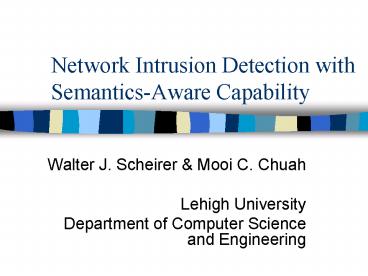Network Intrusion Detection with SemanticsAware Capability - PowerPoint PPT Presentation
1 / 26
Title:
Network Intrusion Detection with SemanticsAware Capability
Description:
Automated attacks have been prevalent for years. Polymorphic threats are real ... popular toolkits for polymorphic exploit generation, and the Code Red II worm. ... – PowerPoint PPT presentation
Number of Views:153
Avg rating:3.0/5.0
Title: Network Intrusion Detection with SemanticsAware Capability
1
Network Intrusion Detection with Semantics-Aware
Capability
- Walter J. Scheirer Mooi C. Chuah
- Lehigh University
- Department of Computer Science and Engineering
2
Motivation
- Computer intrusion is costly
- Automated attacks have been prevalent for years
- Polymorphic threats are real
- Shortcomings in popular intrusion detection
systems (IDS)
3
Whats wrong with snort?
- Signature based IDS requires human intervention
- Original threat recognition
- Signature generation
- Signatures match a specific instance of a threat
- Can be extended with regexps
- Easily defeated with polymorphic code
4
Polymorphism
- Traditional polymorphism has taken the form of an
encrypted body of code with an attached
decryption routine - Decryption routine is often obfuscated
- We term this metamorphism
- Code transpositions, equivalent instruction
substitution, jump insertion, NOP insertion,
garbage instruction insertion, and register
reassignment
5
Polymorphism
6
Dynamic IDS
- Early work focused on sliding-window based
approaches - CMUs Autograph and Polygraph system
- UCSDs Earlybird system
- Premise Some portion of code between
polymorphic/metamorphic instances will be
invariant - Shortcomings too many signatures generated
- Too many false positives
7
Initial Thoughts
- Syntactic approaches (signatures based on
regexps, content blocks coupled with sliding
window schemes, etc.) are inadequate - What if we examine the meaning of the code
instead? - Semantics!
8
Inspiration
- M. Christodorescu, S. Jha, S. Seshia, D. Song and
R. Bryant. Semantics-aware malware detection.
IEEE Security and Privacy Symposium, May 2005. - reduces the problem of semantic equivalency to a
template matching problem
9
Inspiration
- Stated formally
- A program P satisfies a template T (denoted
as P ? T) iff P contains an instruction sequence
I such that I contains a behavior specified by
T. - A template will consist of a sequence of
instructions, along with its associated variables
and symbolic constants.
10
Templates
11
Bringing Semantics to NIDS
- While the initial work formalizes the template
matching problem rather nicely, it presents a
somewhat limited engineering approach to
intrusion detection. - assumes that malware samples are available as
inputs - Prone to false positives (Crypkey, ASProtect)
- Essentially limited to end-host virus detection
- We can improve reliability by adding more to this
process.
12
The Semantics-Aware NIDS Architecture
13
Bringing Semantics to NIDS
- Added features
- smart traffic classifier
- binary data identification and extraction module
- We are extending the semantic detection idea to
incorporate the network scenario.
14
Traffic Classification
- Honeypot scheme
- Widespread scanning scheme
- If a host sends an initial packet to an un-used
address, a count n is initialized. If we continue
to observe this host sending additional packets
to other un-used addresses, the count will be
incremented until it reaches a threshold t - When t is reached, packets emanating from that
suspicious host will be considered for further
analysis
15
Binary Detection and Classification
- Many binary threats are common buffer overflow
exploits - In practice, we observe network buffer overflow
exploits to consist of a well-formed initial
application layer protocol request, with exploit
content usually resembling (but not necessarily
matching exactly) the above encapsulated within
it.
16
Binary Detection and Classification
- By noting what is expected in a protocol request,
and what is abnormal, we can often locate
malicious binary content. - Our module has the ability to distinguish between
acceptable protocol usage and suspicious
repetition.
17
Semantic Analysis
- IDA Pro
- Currently limited to x86
- Prune the code to include only the instructions
we are interested in. Any excess code from the
program frame is discarded. - The templates that we built have the ability to
handle out of order code, NOP insertion, junk
instruction insertion, and register reassignment. - If a piece of code matches one of our templates,
an alert is generated, and further action may be
taken against the offending IP address.
18
Evaluation
- We have conducted an extensive evaluation of our
semantic NIDS, against captured network traffic. - Intel P4 2.8Ghz system with 512MB
- Tested against many stock buffer overflow
exploits, two popular toolkits for polymorphic
exploit generation, and the Code Red II worm. - False positive test a months worth of benign
traffic, with classification disabled
19
Linux Shell Spawning
- The running time for these eight instances ranges
from 2.36 seconds to 3.27 seconds. - The average binary code size is less than
10Kbytes for these exploits.
20
Polymorphic Shellcode Detection
21
Polymorphic Shellcode Detection
22
Code Red II
- Tested 12 5-minute traces collected from two
Class B production networks, each with a total
packet count of over 200,000. - Before evaluation, we noted the correct number of
instances of Code Red II within each capture.
23
Code Red II
24
False Positive Evaluation
- Disabled traffic classification on the NIDS
- Tested a months worth of traffic captured from
two Class C networks (a total capture of 566MB). - Most normal web traffic
- Templates used decryption routines, shell
spawning, Code Red II memory addressing - No false positives!
25
Conclusion
- We have designed and built a NIDS with semantic
analysis capability. - Extensive testing shows highly accurate detection
and no false positives - Improvements
- Traffic classification
- Processing Speed
- More architectures?
26
Questions?































